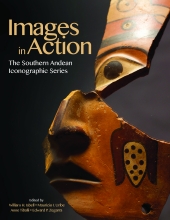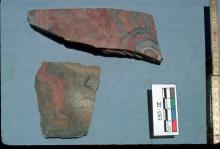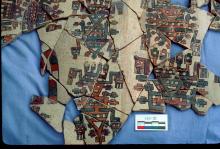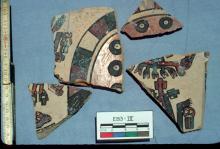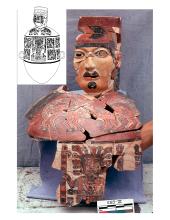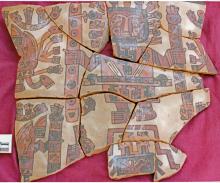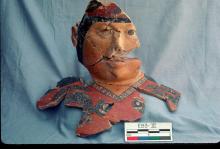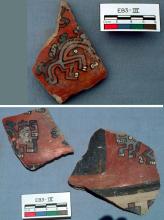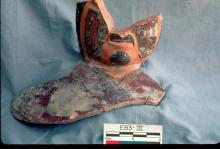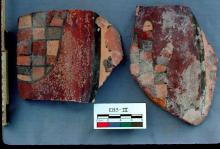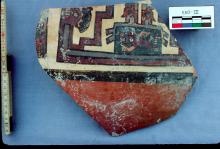Visual database
Two decorated sherds included in the 1977 offering are consistent with design details on vessels from the 2000b offering, located only about 5.5 m away, and cut through Conchopata's Pink Plaza (compare with Figure 15.21). Inclusion of sherds surely from the 2000b offering vessels means that these fragments were probably littering the ceremonial area when the 1977 offering was interred. Although probably close in time, the 2000b offering must be older than the 1977 offering.
The 1977 Conchopata ceramic offering included giant jars decorated in two distinct modes. The less popular mode, depicted here, is related to the Nasca-Ayacucho tradition. It depicts a ventrally extended mythical being with severed heads and squared-off recurved ray designs.
The less popular mode of 1977 offering jars from Conchopata also depict a half-circle or D-shaped figure with columns of circled white dots inside.
Decoration on the popular mode of 1977 offering jars from Conchopata depicts SAIS iconography, although not exclusively. As shown in the reconstruction drawn in the upper left-hand corner, the jars are face-neck human effigies, each representing a male wearing a tunic decorated on the torso area with a Staff God who has two rows of smaller Profile Attendants to his right and left. The upper row of attendants faces away from and the lower row faces toward the Staff God.
Details of the Staff God, its pyramidal pedestal, and Profile Attendants from a 1977 offering jar.
Variations among the face necks of male effigies on the 1977 offering jars include clean faces as well as faces with beard and mustache (15.27). Also appearing are faces with cheek and nose paint, sometimes with and sometimes without beard and mustache (15.31). Variations among the shoulder design, where a tunic neck slit is clearly indicated, include dual felines with peg teeth and tail curving up over the back, apparently of the Nasca-Ayacucho tradition (see also 15.27).
This shoulder of a 1977 offering jar shows an alternative design theme for that area, a field of small humped animals, apparently of the Nasca-Ayacucho tradition.
A fragment of a face-neck jar from the 1977 Conchopata offering shows the elaborately painted cheek decoration (unfortunately the nose, with its painted decoration, is broken off) that appears along with a small beard and mustache. The shoulder area of the figure's tunic is decorated with another alternative theme, checkered hands, apparently shown palm up.
Checkered hands from the shoulder section of 1977 giant offering jars. Photo by William H. Isbell.
The 1977 offering Staff God stands on a pyramidal pedestal with three steps. Inside the pedestal is a rectangular box containing a strange animal oriented horizontally. On the upper surface of the box are two projections with upward-facing feline heads and what may be stylized feathers emanating from the sides of the rectangle.
